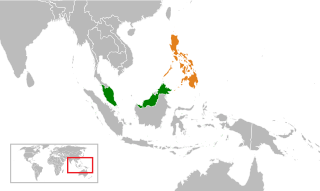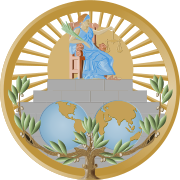
The Sultanate of Sulu was a Muslim state that ruled the Sulu Archipelago, costal areas of Zamboanga City and certain portions of Palawan in the today's Philippines, alongside parts of present-day Sabah, North and East Kalimantan in north-eastern Borneo.

Sebatik Island is an island off the eastern coast of Borneo, partly within Indonesia and partly within Malaysia. It is one of the 92 officially listed outlying islands of Indonesia.

Sipadan is the only oceanic island in Malaysia, rising 600 metres (2,000 ft) from the seabed. It is located in the Celebes Sea off the east coast of Sabah, Malaysia. It was formed by living corals growing on top of an extinct volcanic cone that took thousands of years to develop. Sipadan is located at the heart of the Indo-Pacific basin, the centre of one of the richest marine habitats in the world. More than 400 species of fish and hundreds of coral species have been classified in this ecosystem. Sipadan Island was at the top of Rodale's Scuba Diving Magazine Gold List for 'The Top Dive Destination in the World'. In fact it shared its top spot with 2 other destinations known for the diversity of their marine life — the Galápagos Islands of Ecuador and Truk in Micronesia. Furthermore, one of the dive operators; Scuba Junkie was voted by the public the "Best Dive Resort in the World 2020" at DiveMagazine's annual Dive Travel Awards.

Ligitan is a small island in Tawau, Sabah, located east of the island of Borneo, in the Celebes Sea. In the past, the island was at the centre of a territorial dispute between Malaysia and Indonesia. The matter was brought for adjudication before the International Court of Justice and, at the end of 2002, the Court awarded the island along with the island of Sipadan to Malaysia, on the basis of the "effective occupation" displayed by the latter's predecessor and the absence of any other superior title. The Philippines had applied to intervene in the proceedings on the basis of its claim to Northern Borneo, but its request was turned down by the Court early in 2001.

The North Borneo dispute, also known as the Sabah dispute, is the territorial dispute between Malaysia and the Philippines over much of the eastern part of the state of Sabah. Sabah was previously known as North Borneo prior to the formation of the Malaysian federation.

Kapalai is an island in Tawau Division, Sabah, Malaysia, known for its scuba resorts.
The Philippines has claimed many territories throughout its history. These territories include the Spratly Islands, portions of North Borneo, and the Scarborough Shoal.
Ambalat is a sea block in the Celebes sea located off the east coast of Borneo. It lies to the east of the Indonesian province of North Kalimantan and to the south-east of the Malaysian state of Sabah, and it is the subject of a territorial dispute between the two nations. Malaysia refers to part of the Ambalat block as Block ND6 (formerly Block Y) and part of East Ambalat Block as Block ND7 (formerly Block Z). The deep sea blocks contain an estimated 62,000,000 barrels (9,900,000 m3) of oil and 348 million cubic meters of natural gas. Other estimates place it substantially higher: 764,000,000 barrels (121,500,000 m3) of oil and 3.96 × 1010 cubic meters (1.4 trillion cubic feet) of gas, in only one of nine points in Ambalat.

The Indonesia–Malaysia border consists of a 1,881 km land border that divides the territory of Indonesia and Malaysia on the island of Borneo. It also includes maritime boundaries along the length of the Straits of Malacca, in the South China Sea and in the Celebes Sea.
The borders of Malaysia include land and maritime borders with Brunei, Indonesia and Thailand and shared maritime boundaries with Philippines, Singapore and Vietnam.

The Pedra Branca dispute was a territorial dispute between Singapore and Malaysia over several islets at the eastern entrance to the Singapore Strait, namely Pedra Branca, Middle Rocks and South Ledge. The dispute began in 1979 and was largely resolved by the International Court of Justice (ICJ) in 2008, which opined that Pedra Branca belonged to Singapore and Middle Rocks belonged to Malaysia. Sovereignty over South Ledge belongs to the state in the territorial waters of which it is located.

The Madrid Protocol of 1885 was an agreement between the United Kingdom, German Empire and Spain to recognize the sovereignty of Spain over the Sulu Archipelago as well as the limit of Spanish influence in the region. Under the agreement, Spain relinquishes all claim to Borneo.
The Spanish Government renounces, as far as regards the British Government, all claims of sovereignty over the
territories of the continent of Borneo, which belong, or which have belonged in the past to the Sultan of Sulu (Jolo), and which comprise the neighbouring islands of Balambangan, Banguey, and Malawali, as well as all those comprised within
a zone of three maritime leagues from the coast, and which form part of the territories administered by the Company styled the "British North Borneo Company".

Malaysia–Philippines relations refers to the bilateral relations between Malaysia and the Philippines. The Philippines has an embassy in Kuala Lumpur, and Malaysia has an embassy in Manila and a consulate general in Davao City. The people of the two neighbouring countries have a long history of cultural and political relations.
The Malaysia–Philippines border is a maritime boundary located in the South China, Sulu and Celebes Seas. It separates the Malaysian state of Sabah, which is on the island of Borneo, and the Sulu Islands of the southern Philippines.

The history of Sabah can be traced back to about 23–30,000 years ago when evidence suggests the earliest human settlement in the region existed. The history is interwoven with the history of Brunei and the history of Malaysia, which Sabah was previously part of and is currently part of respectively. The earliest recorded history of Sabah being part of any organised civilisation began in the early 15th century during the thriving era of the Sultanate of Brunei. Prior to this, early inhabitants of the land lived in predominantly tribal societies, although such tribal societies had continued to exist until the 1900s. The eastern part of Sabah was ceded to the Sultan of Sulu by the Sultan of Brunei in 1658 for the former helping a victory over Brunei enemies, but many sources stated it had not been ceded at all. By the late 19th century, both territories previously owned by Sultan of Brunei and Sultan of Sulu was granted to British syndicate and later emerged as British North Borneo under the management of the North Borneo Chartered Company. Sabah became a protectorate of the United Kingdom in 1888 and subsequently became a Crown colony from 1946 until 1963, during which time it was known as Crown Colony of North Borneo. On 16 September 1963, Sabah merged with Malaya, Sarawak and Singapore to form Malaysia.

The 2013 Lahad Datu standoff, also known as the Lahad Datu incursion or Operation Daulat, was a military conflict in Lahad Datu, Malaysia. The conflict began on 11 February, when 235 militants arrived in Lahad Datu by boat, and ended on 24 March. The militants, self proclaimed as "Royal Security Forces of the Sultanate of Sulu and North Borneo", were sent by a claimant to the throne of the Sultanate of Sulu.
Events from the year 2002 in Indonesia

Jamalul Kiram II was the sultan of Sulu from 1894 to 1915. During his long reign, he signed treaties with several nations. He served under both Spain and America.
The borders of Indonesia include land and maritime borders with Malaysia, Papua New Guinea, and East Timor, as well as shared maritime boundaries with Australia, India, Palau, Philippines, Singapore, Thailand, and Vietnam.
The Sebuku River is a river in Borneo that flows from Sabah, Malaysia to Nunukan, in the province of North Kalimantan, Indonesia.













